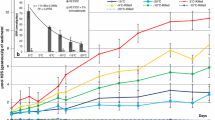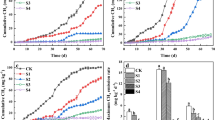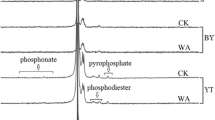Abstract
Inland saline-alkaline wetlands distributed in the mid-high latitude have repeatedly experienced freezing and thawing. However, the response of greenhouse gas (GHG) emission and microbially-mediated carbon and nitrogen cycle to freezing and thawing remains unclear. We monitored the GHG flux in an inland saline-alkaline wetland and found that, compared with the growth period, the average CO2 flux decreased from 171.99 to 76.61–80.71 mg/(m2‧h), the average CH4 flux decreased from 10.72 to 1.96–3.94 mg/(m2‧h), and the average N2O flux decreased from 56.17 to − 27.14 to − 20.70 μg/(m2‧h). Freezing and thawing significantly decreased the relative abundance of functional genes involved in carbon and nitrogen cycles. The aceticlastic methanogenic pathway was the main methanogenic pathway, whereas the Candidatus Methylomirabilis oxyfera was the most abundant methane oxidizer in the wetland. Ammonia-oxidizing archaea and denitrifier belonging to proteobacteria was the major microbial N2O source, while bacteria within clade II nosZ was the major microbial N2O sink. Freezing and thawing reduced the relative abundance of these genes, leading to a decrease in GHG flux.






Similar content being viewed by others
Data Availability
All the raw sequences in this study can be found in the National Center for Biotechnology Information Sequence Read Archive under BioProject PRJNA773918 with the accession number SAMN22543995–SAMN22544000.
Change history
16 March 2023
A Correction to this paper has been published: https://doi.org/10.1007/s00248-023-02205-x
References
Crevecoeur S, Ruiz-González C, Prairie YT, del Giorgio PA (2019) Large-scale biogeography and environmental regulation of methanotrophic bacteria across boreal inland waters. Mol Ecol 28:4181–4196. https://doi.org/10.1111/mec.15223
Sun G, Luo X, Yi F, Zhang X (2000) Concept, distribution law and formation machanism of inland saline alkaline wetland─ ─ taking songliao plain for example. Chin Geogra Sci 10:254–260
Dong G, Zhao F, Chen J, Qu L, Jiang S, Chen J, Xin X, Shao C (2021) Land uses changed the dynamics and controls of carbon-water exchanges in alkali-saline Songnen Plain of Northeast China. Ecol Ind 133:108353. https://doi.org/10.1016/j.ecolind.2021.108353
Chantigny HM, Rochette P, Angers AD, Goyer C, Brin DL, Bertrand N, Chang S (2017) Nongrowing season N2O and CO2 emissions — temporal dynamics and influence of soil texture and fall-applied manure. Can J Soil Sci 97:452–464. https://doi.org/10.1139/cjss-2016-0110
Flesch TK, Baron VS, Wilson JD, Basarab JA, Desjardins RL, Worth D, Lemke RL (2018) Micrometeorological measurements reveal large nitrous oxide losses during spring thaw in Alberta. Atmosphere 9:128
Virkajärvi P, Maljanen M, Saarijärvi K, Haapala J, Martikainen PJ (2010) N2O emissions from boreal grass and grass - clover pasture soils. Agr Ecosyst Environ 137:59–67. https://doi.org/10.1016/j.agee.2009.12.015
Wu X, Brüggemann N, Gasche R, Shen Z, Wolf B, Butterbach-Bahl K (2010) Environmental controls over soil-atmosphere exchange of N2O, NO, and CO2 in a temperate Norway spruce forest. Glob Biogeochem Cycles 24 https://doi.org/10.1029/2009GB003616
Song C, Zhang J, Wang Y, Wang Y, Zhao Z (2008) Emission of CO2, CH4 and N2O from freshwater marsh in northeast of China. J Environ Manage 88:428–436. https://doi.org/10.1016/j.jenvman.2007.03.030
Gao W, Yao Y, Gao D, Wang H, Song L, Sheng H, Cai T, Liang H (2019) Responses of N2O emissions to spring thaw period in a typical continuous permafrost region of the Daxing’an Mountains, northeast China. Atmos Environ 214:116822. https://doi.org/10.1016/j.atmosenv.2019.116822
Song L, Yao Y, Lin L, Gao W, Cai T, Liang H, Gao D (2019) The potential source of nitrous oxide in the pristine riparian marsh during freeze-thaw cycles, case study in Northeast China. Ecol Eng 134:18–25. https://doi.org/10.1016/j.ecoleng.2019.05.004
Buckeridge KM, Cen Y-P, Layzell DB, Grogan P (2010) Soil biogeochemistry during the early spring in low arctic mesic tundra and the impacts of deepened snow and enhanced nitrogen availability. Biogeochem 99:127–141. https://doi.org/10.1007/s10533-009-9396-7
Nyborg M, Laidlaw JW, Solberg ED, Malhi SS (1997) Denitrification and nitrous oxide emissions from a Black Chernozemic soil during spring thaw in Alberta. Can J Soil Sci 77:153–160. https://doi.org/10.4141/s96-105
Li K, Gong Y, Song W, Lv J, Chang Y, Hu Y, Tian C, Christie P, Liu X (2012) No significant nitrous oxide emissions during spring thaw under grazing and nitrogen addition in an alpine grassland. Glob Change Biol 18:2546–2554. https://doi.org/10.1111/j.1365-2486.2012.02704.x
Broadbent AAD, Snell HSK, Michas A, Pritchard WJ, Newbold L, Cordero I, Goodall T, Schallhart N, Kaufmann R, Griffiths RI, Schloter M, Bahn M, Bardgett RD (2021) Climate change alters temporal dynamics of alpine soil microbial functioning and biogeochemical cycling via earlier snowmelt. ISME J 15:2264–2275. https://doi.org/10.1038/s41396-021-00922-0
Dean JF, Middelburg JJ, Röckmann T, Aerts R, Blauw LG, Egger M, Jetten MSM, de Jong AEE, Meisel OH, Rasigraf O, Slomp CP, in’t Zandt MH, Dolman AJ (2018) Methane feedbacks to the global climate system in a warmer world. Rev Geophys 56:207–250. https://doi.org/10.1002/2017RG000559
Ricão Canelhas M, Denfeld BA, Weyhenmeyer GA, Bastviken D, Bertilsson S (2016) Methane oxidation at the water-ice interface of an ice-covered lake. Limnol Oceanogr 61:S78–S90. https://doi.org/10.1002/lno.10288
Samad MS, Bertilsson S (2017) Seasonal variation in abundance and diversity of bacterial methanotrophs in five temperate lakes. Front Microbiol 8:142. https://doi.org/10.3389/fmicb.2017.00142
Vigneron A, Lovejoy C, Cruaud P, Kalenitchenko D, Culley A, Vincent WF (2019) Contrasting winter versus summer microbial communities and metabolic functions in a permafrost thaw lake. Front Microbiol 10:1656. https://doi.org/10.3389/fmicb.2019.01656
Borrel G, Jézéquel D, Biderre-Petit C, Morel-Desrosiers N, Morel J-P, Peyret P, Fonty G, Lehours A-C (2011) Production and consumption of methane in freshwater lake ecosystems. Res Microbiol 162:832–847. https://doi.org/10.1016/j.resmic.2011.06.004
Allen MA, Lauro FM, Williams TJ, Burg D, Siddiqui KS, De Francisci D, Chong KWY, Pilak O, Chew HH, De Maere MZ, Ting L, Katrib M, Ng C, Sowers KR, Galperin MY, Anderson IJ, Ivanova N, Dalin E, Martinez M, Lapidus A, Hauser L, Land M, Thomas T, Cavicchioli R (2009) The genome sequence of the psychrophilic archaeon, Methanococcoides burtonii: the role of genome evolution in cold adaptation. ISME J 3:1012–1035. https://doi.org/10.1038/ismej.2009.45
Hu H-W, Macdonald CA, Trivedi P, Holmes B, Bodrossy L, He J-Z, Singh BK (2015) Water addition regulates the metabolic activity of ammonia oxidizers responding to environmental perturbations in dry subhumid ecosystems. Environ Microbiol 17:444–461. https://doi.org/10.1111/1462-2920.12481
Braker G, Schwarz J, Conrad R (2010) Influence of temperature on the composition and activity of denitrifying soil communities. FEMS Microbiol Ecol 73:134–148. https://doi.org/10.1111/j.1574-6941.2010.00884.x
Szukics U, Abell GCJ, Hödl V, Mitter B, Sessitsch A, Hackl E, Zechmeister-Boltenstern S (2010) Nitrifiers and denitrifiers respond rapidly to changed moisture and increasing temperature in a pristine forest soil. FEMS Microbiol Ecol 72:395–406. https://doi.org/10.1111/j.1574-6941.2010.00853.x
Avrahami S, Liesack W, Conrad R (2003) Effects of temperature and fertilizer on activity and community structure of soil ammonia oxidizers. Environ Microbiol 5:691–705. https://doi.org/10.1046/j.1462-2920.2003.00457.x
Alves BJR, Smith KA, Flores RA, Cardoso AS, Oliveira WRD, Jantalia CP, Urquiaga S, Boddey RM (2012) Selection of the most suitable sampling time for static chambers for the estimation of daily mean N2O flux from soils. Soil Biol Biochem 46:129–135. https://doi.org/10.1016/j.soilbio.2011.11.022
Liu F, Zhang Y, Liang H, Gao D (2021) Resilience of methane cycle and microbial functional genes to drought and flood in an alkaline wetland: a metagenomic analysis. Chemosphere 265:129034. https://doi.org/10.1016/j.chemosphere.2020.129034
Liu F, Zhang Y, Liang H, Gao D (2019) Long-term harvesting of reeds affects greenhouse gas emissions and microbial functional genes in alkaline wetlands. Water Res 164:114936. https://doi.org/10.1016/j.watres.2019.114936
Holst J, Liu C, Yao Z, Brüggemann N, Zheng X, Giese M, Butterbach-Bahl K (2008) Fluxes of nitrous oxide, methane and carbon dioxide during freezing–thawing cycles in an Inner Mongolian steppe. Plant Soil 308:105–117. https://doi.org/10.1007/s11104-008-9610-8
Ren J, Song C, Hou A, Song Y, Zhu X, Cagle GA (2018) Shifts in soil bacterial and archaeal communities during freeze-thaw cycles in a seasonal frozen marsh, Northeast China. Sci Total Environ 625:782–791. https://doi.org/10.1016/j.scitotenv.2017.12.309
Aanderud ZT, Jones SE, Schoolmaster DR, Fierer N, Lennon JT (2013) Sensitivity of soil respiration and microbial communities to altered snowfall. Soil Biol Biochem 57:217–227. https://doi.org/10.1016/j.soilbio.2012.07.022
Bastviken D, Tranvik LJ, Downing JA, Crill PM, Enrich-Prast A (2011) Freshwater methane emissions offset the continental carbon sink. Sci 331:50. https://doi.org/10.1126/science.1196808
Yang J, Zhou W, Liu J, Hu X (2014) Dynamics of greenhouse gas formation in relation to freeze/thaw soil depth in a flooded peat marsh of Northeast China. Soil Biol Biochem 75:202–210. https://doi.org/10.1016/j.soilbio.2014.04.006
Panikov NS, Dedysh SN (2000) Cold season CH4 and CO2 emission from boreal peat bogs (West Siberia): winter fluxes and thaw activation dynamics. Global Biogeochem Cycles 14:1071–1080
Rasse DP, Rumpel C, Dignac M-F (2005) Is soil carbon mostly root carbon? Mechanisms for a specific stabilisation. Plant Soil 269:341–356. https://doi.org/10.1007/s11104-004-0907-y
Cheng L, Zhang N, Yuan M, Xiao J, Qin Y, Deng Y, Tu Q, Xue K, Van Nostrand JD, Wu L, He Z, Zhou X, Leigh MB, Konstantinidis KT, Schuur EAG, Luo Y, Tiedje JM, Zhou J (2017) Warming enhances old organic carbon decomposition through altering functional microbial communities. ISME J 11:1825–1835. https://doi.org/10.1038/ismej.2017.48
Vester JK, Glaring MA, Stougaard P (2015) An exceptionally cold-adapted alpha-amylase from a metagenomic library of a cold and alkaline environment. Appl Microbiol Biotechnol 99:717–727. https://doi.org/10.1007/s00253-014-5931-0
Xue D, Zeng X, Gong C, Lin D, Yao S (2018) A cold adapt and ethanol tolerant endoglucanase from a marine Bacillus subtilis. Chin J Chem Eng 26:2601–2606. https://doi.org/10.1016/j.cjche.2018.02.007
Gao D, Liu Z, Bai E (2021) Effects of in situ freeze-thaw cycles on winter soil respiration in mid-temperate plantation forests. Sci Total Environ 793:148567. https://doi.org/10.1016/j.scitotenv.2021.148567
Andersen R, Chapman SJ, Artz RRE (2013) Microbial communities in natural and disturbed peatlands: a review. Soil Biol Biochem 57:979–994. https://doi.org/10.1016/j.soilbio.2012.10.003
Wu XL, Chin KJ, Stubner S, Conrad R (2001) Functional patterns and temperature response of cellulose-fermenting microbial cultures containing different methanogenic communities. Appl Microbiol Biotechnol 56:212–219. https://doi.org/10.1007/s002530100622
Fey A, Claus P, Conrad R (2004) Temporal change of 13C-isotope signatures and methanogenic pathways in rice field soil incubated anoxically at different temperatures. Geochim Cosmochim Acta 68:293–306. https://doi.org/10.1016/S0016-7037(03)00426-5
Schulz S, Matsuyama H, Conrad R (1997) Temperature dependence of methane production from different precursors in a profundal sediment (Lake Constance). FEMS Microbiol Ecol 22:207–213. https://doi.org/10.1016/S0168-6496(96)00091-8
Kotsyurbenko OR, Nozhevnikova AN, Zavarzin GA (1993) Methanogenic degradation of organic matter by anaerobic bacteria at low temperature. Chemosphere 27:1745–1761. https://doi.org/10.1016/0045-6535(93)90155-X
Großkopf R, Janssen PH, Liesack W (1998) Diversity and structure of the methanogenic community in anoxic rice paddy soil microcosms as examined by cultivation and direct 16S rRNA gene sequence retrieval. Appl Environ Microbiol 64:960–969. https://doi.org/10.1128/AEM.64.3.960-969.1998
Hu B, Shen L, Lian X, Zhu Q, Liu S, Huang Q, He Z, Geng S, Cheng D, Lou L, Xu X, Zheng P, He Y (2014) Evidence for nitrite-dependent anaerobic methane oxidation as a previously overlooked microbial methane sink in wetlands. Proc Natl Acad Sci 111:4495–4500. https://doi.org/10.1073/pnas.1318393111
Chen F, Zheng Y, Hou L, Niu Y, Gao D, An Z, Zhou J, Yin G, Dong H, Han P, Liang X, Liu M (2021) Microbial abundance and activity of nitrite/nitrate-dependent anaerobic methane oxidizers in estuarine and intertidal wetlands: heterogeneity and driving factors. Water Res 190:116737. https://doi.org/10.1016/j.watres.2020.116737
Shen L-d, Tian M-h, Cheng H-x, Liu X, Yang Y-l, Liu J-q, Xu J-b, Kong Y, Li J-h, Liu Y (2020) Different responses of nitrite- and nitrate-dependent anaerobic methanotrophs to increasing nitrogen loading in a freshwater reservoir. Environ Pollut 263:114623. https://doi.org/10.1016/j.envpol.2020.114623
Hallin S, Philippot L, Loffler FE, Sanford RA, Jones CM (2018) Genomics and ecology of novel N2O-reducing microorganisms. Trends Microbiol 26:43–55. https://doi.org/10.1016/j.tim.2017.07.003
Graves CJ, Makrides EJ, Schmidt VT, Giblin AE, Cardon ZG, Rand DM (2016) Functional responses of salt marsh microbial communities to long-term nutrient enrichment. Appl Environ Microbiol 82:2862–2871. https://doi.org/10.1128/aem.03990-15
Funding
This research was supported by the National Natural Science Foundation of China (No. 31470543) and the Key Technology Research and Development Program of Henan (Nos. 222102320379 and 222102320197).
Author information
Authors and Affiliations
Contributions
Yupeng Zhang: Conceptualization, investigation, formal analysis, visualization, and writing—original draft. Fengqin Liu: Resources, project administration, review and editing, and data curation. Hong Liang: Writing—review and editing, supervision, and funding acquisition. Dawen Gao: Investigation and visualization.
Corresponding authors
Ethics declarations
Ethics Approval and Consent to Participate
Not applicable.
Consent for Publication
Not applicable.
Conflict of Interest
The authors declare no competing interests.
Supplementary Information
Below is the link to the electronic supplementary material.
Rights and permissions
Springer Nature or its licensor (e.g. a society or other partner) holds exclusive rights to this article under a publishing agreement with the author(s) or other rightsholder(s); author self-archiving of the accepted manuscript version of this article is solely governed by the terms of such publishing agreement and applicable law.
About this article
Cite this article
Zhang, Y., Liu, F., Liang, H. et al. Mediative Mechanism of Freezing/Thawing on Greenhouse Gas Emissions in an Inland Saline-Alkaline Wetland: a Metagenomic Analysis. Microb Ecol 86, 985–996 (2023). https://doi.org/10.1007/s00248-022-02165-8
Received:
Accepted:
Published:
Issue Date:
DOI: https://doi.org/10.1007/s00248-022-02165-8




